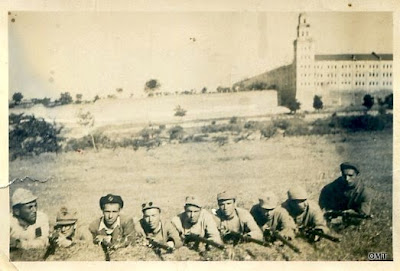”Men are all alike – except the one you’ve met who’s different.”
Mae West
What if back in the mid-1970s a Turkish record producer came up with a concept that would take disco out of the clubs and on to the top 40, a boy band for people who’d lost their innocence a while back? The five men fronting the group would be professional performers, not specifically singers, dancers or actors but a bit of all three. Forget art, this would be theatre. The performers would dress as Turkish stereotypes and everyone would get the irony immediately. Even old conservatives fundamentally opposed to the notion of gay men dressing up as Turkish stereotypes wouldn’t be able to stop themselves humming the tunes and practising the steps in front of the mirror. One of the performers, probably the front man, would be an Ottoman gazi or pasha (though a tea seller would suffice). Wearing a fez and a ridiculous moustache, he’d punch the air and twirl about as he led the anthemic chants for the other four. He might be centre stage but he wouldn’t necessarily be the star. The genius of the concept was that the audience always had their personal favourites.
Among the other four one had to be an army officer. Impeccably dressed down to his Sam Browne belt and jackboots, he’d represent that schizophrenic relationship Turks had with their army; part selfless defender of the borders, part instrument of dictatorship. When it came to minorities the producer needed to tread carefully. Some people had no sense of humour and might respond with bombs. Having someone dress up as an Arab could work. It acknowledged the imperialist past and think of him not as an Arab but as Peter O’Toole in Lawrence of Arabia and even the Arabs would laugh along.
Who was left? A policeman? There was already the army officer and the uniforms not to mention the political implications were already too close. A construction worker? No one would get that. How about a gangster of some description? By the mid-70s a fair number of real life gangsters were convinced they were living the dream, part Michael Corleone, part Little Caesar and besides, at that time people the world over believed gangsters were swarthy Mediterranean types. The last member of the group required some deliberation. How about an athlete? In the mid-70s Turkey didn’t have an international reputation for excellence in many areas but it had produced a succession of wrestlers and weightlifters who were more agile and could lift a lot more than anyone else around. Let the Americans triumph at short course running events, how many of them could raise twice their weight above their heads and hold it there? Put one of the performers in a wresting costume and it was like putting a beret and a handlebar moustache on someone and calling him French.
In the middle of the last century especially it was common for people to go to a studio to have their portrait taken, get a dozen or so prints that they could put in their wallet and distribute to whomever they thought required them. The idea was to get an image that distinguished the sitter’s individuality, or in other words their better side. What we end up with however are images that correspond to stereotypes. Maybe Jack Nicholson was right, there really are only twelve types of men on the planet, or possibly people in these photos look like stereotypes because that is the easiest reference point we have for them. One of the men in the gallery looks like a cross between a young Phil Silvers and an insurance salesman from Midwest America (hat, glasses, pin on lapel). There might not be a place for him onstage with the group but he’d make an excellent PR agent. It’s one of the strange things about these portraits; we always feel like we already know the person.
VIEW THE GALLERY HERE
 |
| BOYS WILL BE BOYS |























